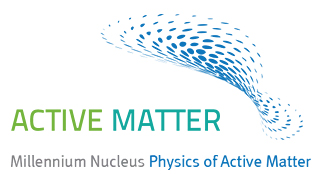• Physicists from the Millennium Nucleus Physics of Active Matter demonstrated that groups of bacteria are capable to organize to move the drop of water in which they are inserted, and that movement can be monitored and controlled externally. This opens a range of possibilities in biotechnology and remote-controlled medicine.
Have you ever seen how flocks of birds or shoals of fiches move? Even though they are groups of animals, they move as if they were a single organism. The bacterial suspension also moves collectively. An open question about these systems, that physicists call “active matter”, is if the energy they take from the environment to move like a hive can be used to move something more than themselves.
A team of scientists from the Millennium Nucleus of the Active Matter demonstrated for the first time that not only that is possible, but also that movement could be controlled externally by creating biological micromotors, which opens unsuspected future applications in biotechnology and medicine.
Self-organization
Gabriel Ramos, physicist and Ph.D. student on the Millennium Nucleus Physics of Active Matter, under the direction of María Luisa Cordero, Alternate Director and Rodrigo Soto, Director of the Millennium Nucleus of the University of Chile, put micro drops of water, hair-thin width, in small channels surrounded by oil.
Inside every drop, the physicist introduced millions of escherichia coli (E. coli) bacteria with the objective of study its collective movement.
Something unexpected happened next and Maria Luisa Cordero, Academic from the Physics Department of the FCFM of the University of Chile, expert in microfluidics and person in charge of the experiments support, explains it: “bacteria were moving everywhere inside the drop, but soon they started to swim along in groups, collectively, just like a shoal. They tended to move towards the edge of the drop and started to form whirls. Suddenly, they organized themselves and several internal whirls made the drop spin in one direction allowing the drop to move inside the oil channel.
Gabriel Ramos says that this finding is very important since, until now, it was known that living bacteria could move collectively, but they did not know they can move the drop in which they were inserted or that they were able to self-organize.
E. coli looks for oxygen in the natural environment, so they will use this compound to see if they can control the drop movement. “The E. coli advantage is that responds to chemical signals so we could control the drop movement and make it go anywhere we want”, Ramos says.
Micromotors
The drop of water moves thanks to the collective movement of the bacteria inside it, is an example of a biological motor and it is not the only one that physicists of the Millennium Nucleus Physics of Active Matter have developed.
Benefited from a collaborative work between the Millennium Nucleus and European physicists, Gabriel Ramos took his work to the Eric Clement Laboratory. Eric is Physicist of the ESPCI, France.
That is how Ramos, in cooperation with the French Ph.D. student Benoit Vincenti performed a new experiment with magnetotactic bacteria, under the supervision of their professors in Chile and France.
These bacteria naturally have a little magnet inside that allows them to use the earth’s magnetic field to swim in the deep ocean to save zones so they can feed and reproduce.
In the ESPCI Laboratory in France, physicists put thousands of magnetotactic bacteria inside a micro drop of water but on this occasion, they applied a magnetic field. What happened next is that bacteria made the drop spin towards the place where the magnetic field was being applied which means that “we have a motor that can be controlled “
This research will be soon published in Nature Communications magazine.
Gabriel Ramos explains that this experiment, as well as the other one, has biological micromotors that, in the future, could help to create devices to transport some compounds in biochemical applications, extract energy from the rotation of the drop to generate electronic microdevices, biobatteries or help researchers in the medicine area to design new controlled ways to transport medication inside the body.
The applications are unsuspected. For now, this scientific team already showed that, at a collective level, “bacteria can move an object that is a hundred times bigger than them”, Rodrigo Soto says.
Review the paper here: https://www.explora.cl/blog/robots-microbiologicos-chilenos/
See our animated capsule where we explain everything about our micromotors’ work. (with subtitles in English):

